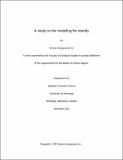| dc.identifier.citation | Lim, Serena Sungyoung. A study on the modeling for obesity; A thesis submitted to the Faculty of Graduate Studies in partial fulfillment of the requirements for the Master of Science degree, Department of Applied Computer Science, University of Winnipeg. Winnipeg, Manitoba, Canada: University of Winnipeg, December 2021. DOI: 10.36939/ir.202112171547. | en_US |
| dc.description.abstract | This study primarily aims to develop an Agent Based Model (ABM) that can simulate the obesity rates based on statistical analysis and to find out how obesity is affected by risk factors in a Canadian environment. As obesity can have many causes, it is assumed that various risk factors, not just a decisive one, have an influence on obesity and they interact with one another. Therefore, unlike most previous studies, I approached the obesity problem as a Complex -Adaptive System (CAS). The data used for this study was provided by Statistics Canada, and the Canadian Community Health Survey (CCHS). This survey is a cross-sectional survey that collects self-reported information related to health status, health care utilization, and health determinants for the Canadian population. To build the Obesity ABM, it is necessary to find out which risk factors are closely associated with obesity and to what extent they interact with one another. Twelve categories of factors that are expected to influence the obesity rate were chosen on the basis of the related works. Through the statistical data analysis carried out, the main factors and variables for obesity were identified and their respective mathematical relationships obtained. From this, two categories that have several sub-factors for the obesity model were chosen. I implemented statistical data analysis on the CCHS dataset to see the interrelationship among the factors. Also, I implemented a year-to-year analysis that can show how people change their obesity status each year. Based on the data analysis result, I defined rules for how each risk factor changes each year. These rules are applied to the obesity model using NetLogo. The architecture of obesity model implementation consists of three main parts: The population module, the risk factor module, and the results module. Performance evaluation was conducted to examine whether the obesity model can simulate the obesity rate. For this evaluation, the data of CCHS from 2009 to 2014 and the result of the obesity model which is generated by simulation are compared. Model calibration was executed to fit the actual data to the model test result. The result of the model test shows that the percentage error is less than 5%. This means that the obesity model has high validity in predicting obesity for each risk factor. The obesity ABM is a useful tool to find out the risk factors related to obesity and their relationships in the Canadian population. Thus, this model can potentially assist to improve obesity management at various levels. At the individual level, everyone can find what kinds of strategies are best fit to improve her/his physical condition. Also, at a government or community level, it could help develop policies for people to continue to implement these strategies well. This will lead to reducing the associated social costs and help to promote national health. | en_US |

